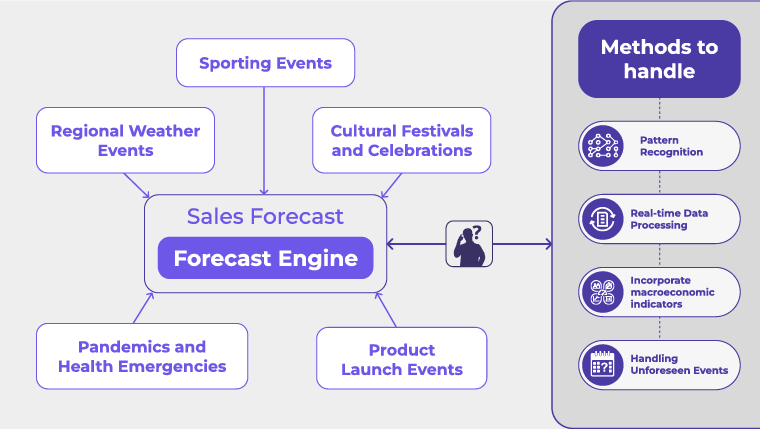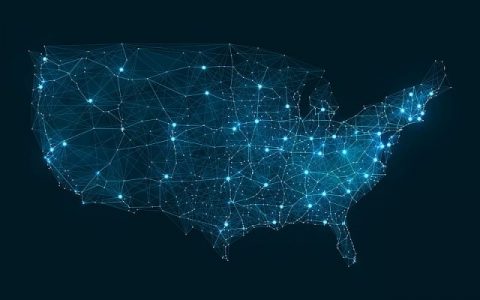This is the second in a series of blogs pulling back the curtain on Impact Analytics ForecastSmart™ AI-based demand forecasting software.
Predicting demand accurately is key to staying competitive. However, demand forecasting is no longer just about understanding the usual trends. Retail demand for products or services is influenced by a myriad of factors, some of which are unique to a specific geography. Additionally, rare, unforeseen events, such as a global pandemic, a one-time marketing campaign, or viral trends, can suddenly spike or depress demand and completely change the game. Your ability to account for these rare or extreme events, as well as weather variations and macroeconomic shifts, is pivotal.
Recently, the impact of weather fluctuations and macroeconomic conditions on consumer behaviors has been noticeably significant. Supply chains, crucial for global trade, have been disrupted, causing delays and shortages across the globe. Moreover, market demands have become more volatile as the delicate balance between supply and demand constantly shifts. These interconnected influences highlight the need for adaptable strategies able to navigate these ever-evolving challenges.
Conventional retail demand forecasting software often stumbles when confronting rare events like pandemics, natural disasters, or economic downturns. Incorporating these factors requires a sophisticated methodology that integrates regime models, adaptive algorithms, and a comprehensive analysis of external factors.
This is where artificial intelligence comes to the rescue.
In this blog I’ll focus on how AI-enabled demand forecasting tools handle unpredictable events—how AI adapts and learns from unexpected occurrences, enabling businesses to anticipate and navigate the unpredictable to stay ahead of the curve. I’ll also lay out some real-world scenarios to illustrate AI’s importance.
 Advanced AI Tools for Retail Demand Forecasting
Advanced AI Tools for Retail Demand Forecasting
The ability of AI-based retail demand forecasting software to detect, analyze, and predict the impact of rare events has revolutionized the retail business. It empowers organizations to make informed decisions, adapt their strategies, and stay agile.
The best AI-based retail demand forecasting software particularly demonstrates its superiority when decoding and addressing unexpected occurrences that significantly influence market behavior. Its ability to discern subtle patterns in historical data, and swiftly adapt to emerging trends sparked by unforeseen events, is immensely valuable.
However, I’ll highlight right at the outset that the relationship between AI and human insights is vital. Any demand forecasting engine, whether or not it’s used in retail, must enable domain experts to add their invaluable input. AI predictions become more refined when blending empirical data with the real-world experience of human experts. The most accurate demand forecasts use AI-based multimodeling combined with expert human reviews to address complexities such as rare events, structural shifts, weather fluctuations, macroeconomic factors, and other episodic variables.
Enhanced Pattern Recognition and Anomaly Detection
AI models, particularly machine learning (ML) algorithms, excel in recognizing complex patterns within historical data. Multimodel or hybrid models employ techniques like time series analysis, recurrent neural networks (RNNs), or long short-term memory (LSTM) networks to identify subtle anomalies or shifts in demand patterns that might signal rare events. For instance, structural-break analysis methods/regime models are used to detect significant shifts in data patterns, enabling the system to adapt and adjust forecasting models accordingly.
Real-time Data Processing and Dynamic Forecasting
AI’s ability to process vast amounts of real-time data enables dynamic forecasting. When dealing with rare events, such as sudden changes in consumer behavior due to unexpected factors, AI models incorporate this information swiftly into the forecasting process. AI demand forecasting systems can integrate weather forecasts and historical weather data into their models using techniques like time series decomposition or weather normalization methods to isolate weather effects from underlying demand patterns.
Forecasting Macroeconomic Factors
AI demand forecasting tools incorporate macroeconomic indicators such as GDP, inflation rates, and consumer confidence indices as additional features. Autoregressive integrated moving average (ARIMA) and regression-based models, and others, can be extended to include these broader economic trends in the forecasting.
Handling Unforeseen Events and Tourist Index
Adaptable demand forecasting models are required to address events such as spontaneous local festivals, sudden tourism influx, or unexpected market shifts that are not historically documented. Neural networks models can learn from real-time data and adjust their predictions accordingly. For instance, recurrent neural networks (RNNs) or attention-based models capture sequential information and learn patterns from non stationary data, enabling the system to respond to new, unrecorded events.
Long-term Impact Assessment and Refinement
AI-based retail demand forecasting systems continuously learn and adapt from new data. After a rare product launch or unforeseen event, such models analyze the longer-term impact and adjust future forecasts based on these insights. Reinforcement learning techniques help refine forecasting models by incorporating feedback loops from actual post-event sales data, enhancing the accuracy of future predictions.
Ultimately, the strength of AI in demand forecasting lies in its ability to adapt, learn from new information, and handle diverse and dynamic datasets to provide more accurate predictions, especially in the face of rare and unforeseen events. By continuously learning and adapting in real-time, these models equip businesses with actionable insights, aiding in risk assessment, dynamic forecasting, and targeted marketing strategies tailored to diverse economic conditions.
AI Retail Demand Forecasting in the Real World
- Regional Weather Events—A sudden and severe snowstorm hits a particular region, increasing the demand for snow shovels and decreasing demand for outdoor, fair weather products. Imagine a sunny region hit by a surprise heavy snowfall. While people aren’t thinking about warm-weather clothes, they rush to buy winter attire like coats and boots. By accommodating such events in the forecasting model, the forecast process should be able to analyze historical weather data and sales patterns to anticipate and adapt to such weather-driven fluctuations in demand. An apparel retailer might use AI insights to increase stock for snow-ready attire before the snowstorm hits, ensuring they’re ready to meet the sudden demand for winter wear.
- Sporting Events—Hosting a major sporting event or game leads to increased demand for various goods and services, including food, merchandise, and accommodations. AI-enabled forecast systems help retailers to identify correlations between past sporting events and spikes in demand—and adjust their strategies accordingly. It recommends stocking up on jerseys and accessories related to the teams playing, ensuring they’re prepared for the surge in demand during the event.
- Cultural Festivals and Celebrations—Some annual cultural festivals that attract tourists. Apparel retailers have to adjust the forecast by understanding what type of festivals occur and what clothing items tend to sell more. For example, during a cultural festival showcasing traditional dance or music, a clothing boutique might anticipate a higher demand for ethnic wear and stock up on culturally inspired clothing based on insights.
- Pandemics and Health Emergencies—Global pandemics, such as COVID-19, impact demand patterns significantly, increasing the demand for medical supplies and reducing demand for non-essential goods and services. In times of health crises, people’s clothing preferences might change. For example, a surge in demand for comfortable loungewear or activewear for home workouts.Any apparel store might rely on AI to foresee increased demand for loungewear or workout gear and adjust their inventory accordingly.
- Product Launch Events—A tech company’s product launch generates a surge in demand for the new product and related accessories. The introduction of a new product often results in erratic sales patterns, making it complex to anticipate post-launch demand. While these events generate short-term peaks in sales, their effects on long-term forecasting can be intricate. Factors like initial consumer enthusiasm, market reception, and the novelty of the new product and its features heavily influence immediate sales. Modern forecasting processes started using AI/ML models to track product launch events and their effects on demand, enabling businesses to optimize their strategies.
Beyond the above rare events, economic changes exert a profound influence on consumer behavior, causing a direct ripple effect in sales patterns. During periods of economic prosperity, consumers tend to embrace a more liberal spending mindset, indulging in nonessential purchases and luxury items. In contrast, economic downturns prompt a shift in consumer behavior toward frugality, where essential goods take precedence over discretionary spending. Integrating macroeconomic factors into sales forecasting is pivotal for accurate predictions. AI/ML play a pivotal role by sifting through extensive historical sales data and economic indicators.
Impact Analytics Forecastsmart: The Premier AI-based Demand Forecasting Engine
Impact Analytics ForecastSmart™ operates on a sophisticated hierarchical multimodel strategy that incorporates various layers of analysis. Initially, individual models, some nonlinear and others linear, provide a diverse range of predictions, showcasing varied performance across economic scenarios and timeframes. However, through post-modeling corrections, such as bias adjustments and trend assessments based on the previous year’s data, it ensures a refinement on the forecasts. Additionally, a sense-check-based correction mechanism further enhances the accuracy by validating predictions against real-time conditions.
The integration of these corrections into the multi-model strategy enables a comprehensive approach that balances historical insights with current data. This synthesis ensures adaptability to shifting economic landscapes, supporting the pursuit of more accurate and agile forecasts, especially crucial amidst evolving business cycles.
Quantifying the benefits of AI in Impact Analytics demand forecasting software is crucial for a data-driven understanding of its impact. By harnessing the power of AI, our clients are experiencing a substantial improvement in forecast accuracy, often by as much as 20%, leading to a direct reduction of excess inventory costs by approximately 15%. Additionally, AI integration can optimize supply chain operations, resulting in a remarkable 30% reduction in operational expenses.
Take the Next Step
The tangible advantages noted above underscore the paramount importance of choosing the right AI-enabled demand forecasting system.
Impact Analytics ForecastSmart—Take advantage of advanced machine learning algorithms to generate precise forecasts for every SKU, at any store, style, or hierarchy level, throughout every lifecycle.
Read Automated Style Chaining—The #1 blog in the AI Retail Demand Forecast Technology series
Read Cold Start Modeling—The #3 blog in the AI Retail Demand Forecast Technology series






